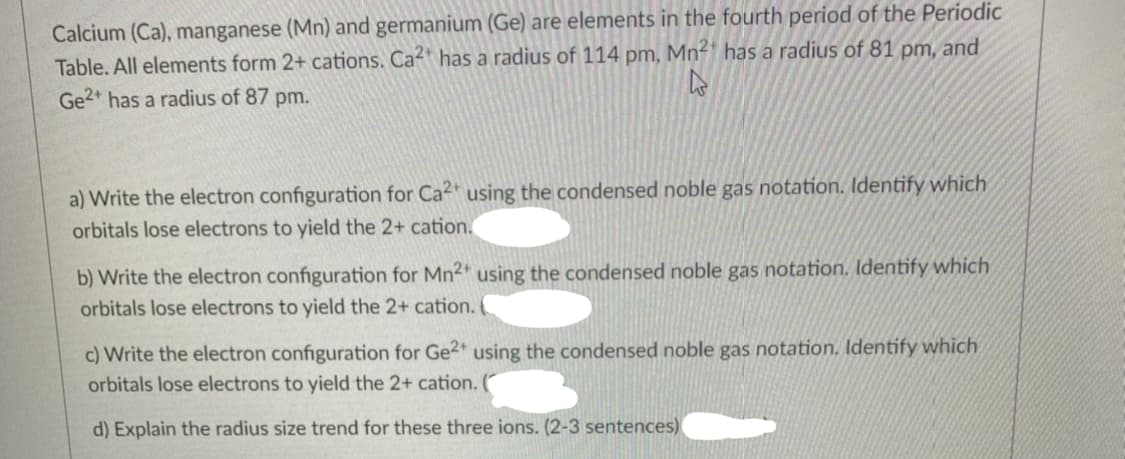Calcium (Ca), manganese (Mn) and germanium (Ge) are elements in the fourth per Table. All elements form 2+ cations. Ca has a radius of 114 pm, Mn-* has a radius of 81 pm, and Ge2 has a radius of 87 pm. a) Write the electron configuration for Ca2 using the condensed noble gas notation. Identify which orbitals lose electrons to yield the 2+ cation. b) Write the electron configuration for Mn2 using the condensed noble gas notation. Identify which orbitals lose electrons to yield the 2+ cation. c) Write the electron configuration for Ge2 using the condensed noble gas notation. Identify which orbitals lose electrons to yield the 2+ cation. ( d) Explain the radius size trend for these three ions. (2-3 sentences)
Calcium (Ca), manganese (Mn) and germanium (Ge) are elements in the fourth per Table. All elements form 2+ cations. Ca has a radius of 114 pm, Mn-* has a radius of 81 pm, and Ge2 has a radius of 87 pm. a) Write the electron configuration for Ca2 using the condensed noble gas notation. Identify which orbitals lose electrons to yield the 2+ cation. b) Write the electron configuration for Mn2 using the condensed noble gas notation. Identify which orbitals lose electrons to yield the 2+ cation. c) Write the electron configuration for Ge2 using the condensed noble gas notation. Identify which orbitals lose electrons to yield the 2+ cation. ( d) Explain the radius size trend for these three ions. (2-3 sentences)
Chemistry: The Molecular Science
5th Edition
ISBN:9781285199047
Author:John W. Moore, Conrad L. Stanitski
Publisher:John W. Moore, Conrad L. Stanitski
Chapter5: Electron Configurations And The Periodic Table
Section: Chapter Questions
Problem 116QRT
Related questions
Concept explainers
Atomic Structure
The basic structure of an atom is defined as the component-level of atomic structure of an atom. Precisely speaking an atom consists of three major subatomic particles which are protons, neutrons, and electrons. Many theories have been stated for explaining the structure of an atom.
Shape of the D Orbital
Shapes of orbitals are an approximate representation of boundaries in space for finding electrons occupied in that respective orbital. D orbitals are known to have a clover leaf shape or dumbbell inside where electrons can be found.
Question

Transcribed Image Text:Calcium (Ca), manganese (Mn) and germanium (Ge) are elements in the fourth period of the Periodic
Table. All elements form 2+ cations. Ca has a radius of 114 pm, Mn²* has a radius of 81 pm, and
Ge2* has a radius of 87 pm.
a) Write the electron configuration for Ca2* using the condensed noble gas notation. Identify which
orbitals lose electrons to yield the 2+ cation.
b) Write the electron configuration for Mn2 using the condensed noble gas notation. Identify which
orbitals lose electrons to yield the 2+ cation.
c) Write the electron configuration for Ge2 using the condensed noble gas notation. Identify which
orbitals lose electrons to yield the 2+ cation.
d) Explain the radius size trend for these three ions. (2-3 sentences)
Expert Solution
This question has been solved!
Explore an expertly crafted, step-by-step solution for a thorough understanding of key concepts.
This is a popular solution!
Trending now
This is a popular solution!
Step by step
Solved in 2 steps

Knowledge Booster
Learn more about
Need a deep-dive on the concept behind this application? Look no further. Learn more about this topic, chemistry and related others by exploring similar questions and additional content below.Recommended textbooks for you

Chemistry: The Molecular Science
Chemistry
ISBN:
9781285199047
Author:
John W. Moore, Conrad L. Stanitski
Publisher:
Cengage Learning

General Chemistry - Standalone book (MindTap Cour…
Chemistry
ISBN:
9781305580343
Author:
Steven D. Gammon, Ebbing, Darrell Ebbing, Steven D., Darrell; Gammon, Darrell Ebbing; Steven D. Gammon, Darrell D.; Gammon, Ebbing; Steven D. Gammon; Darrell
Publisher:
Cengage Learning


Chemistry: The Molecular Science
Chemistry
ISBN:
9781285199047
Author:
John W. Moore, Conrad L. Stanitski
Publisher:
Cengage Learning

General Chemistry - Standalone book (MindTap Cour…
Chemistry
ISBN:
9781305580343
Author:
Steven D. Gammon, Ebbing, Darrell Ebbing, Steven D., Darrell; Gammon, Darrell Ebbing; Steven D. Gammon, Darrell D.; Gammon, Ebbing; Steven D. Gammon; Darrell
Publisher:
Cengage Learning


Chemistry & Chemical Reactivity
Chemistry
ISBN:
9781337399074
Author:
John C. Kotz, Paul M. Treichel, John Townsend, David Treichel
Publisher:
Cengage Learning

Chemistry & Chemical Reactivity
Chemistry
ISBN:
9781133949640
Author:
John C. Kotz, Paul M. Treichel, John Townsend, David Treichel
Publisher:
Cengage Learning

Chemistry: An Atoms First Approach
Chemistry
ISBN:
9781305079243
Author:
Steven S. Zumdahl, Susan A. Zumdahl
Publisher:
Cengage Learning